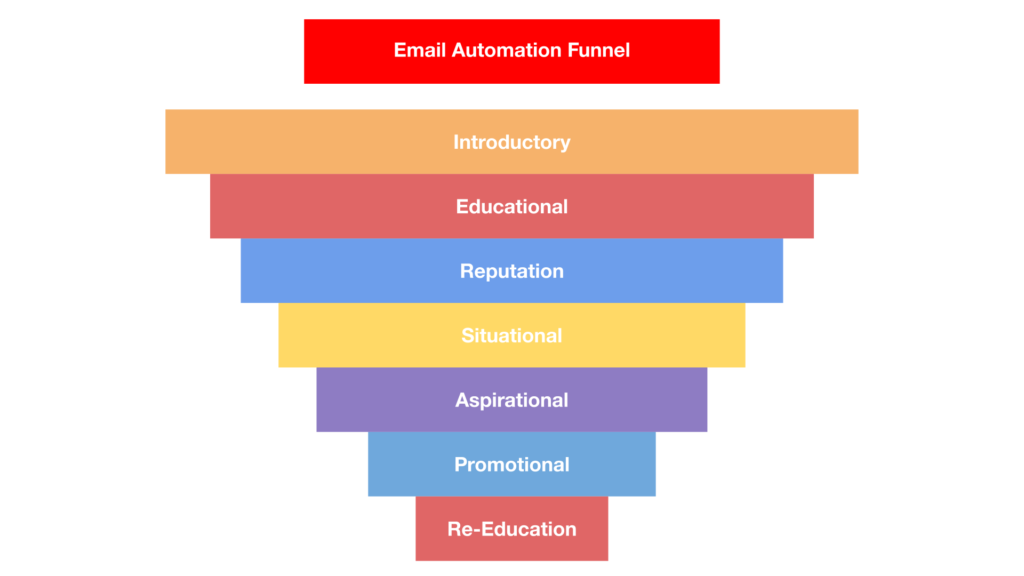When crafting email marketing campaigns, it is important to consider your overall funnel strategy to nurture prospects into customers. After extensive testing and analysis over the years with global brands, here are the emails you should be including in your automation sequence:

Let’s talk about the sequence. The funnel starts at the top, with your total number of qualified leads decreasing as we go down. That is normal, as you want to be validating your leads based on email interaction. Each email should be spaced at least three days apart, to avoid over-sending to prospects (and annoying them).
Introductory is the welcome email typically paired with a content offer. Here you will give the prospect something you promised in order to originally secure their email. A common offer is a monthly newsletter, but you can take this a step further. How about giving a checklist, e-book or course? These offers alone will build incredible rapport and start your relationship off on the right foot.
Educational is an email with one intention: to inform. Examples include “did you know?”, tips, advice and how-to’s. Instead of expecting a sale, what can you do to educate and inform your prospects, without expectation? This email might be an extension of your first email, if you gave an educational content offer. You can never do enough educating when it comes to the customer. If you are having trouble coming up with what to write, consider compiling old blog or social media posts into a helpful email.
Reputation is about demonstrating your credibility in the industry. Consider showing off reviews, testimonials, mentions and statistics about your popularity. Maybe you have some case studies and experiences to share. This is your chance to say you are trustworthy and you deliver.
Situational is all about outlining the present limitations of the prospect. Right now, this prospect is worse off for not being your customer. Remind them of where they are now, and where they could be. Focus on fears, worries, obstacles, roadblocks, inertia, anything getting in the way of the prospect’s life.
Aspirational is an add-on to the last email. Now that we’ve addressed inadequacies, it’s time to break the status quo with motivation. You are going to say what the prospect can have by being your customer. List all of the benefits. Show how you handle their worries and fears. It really helps if you can solve a clear problem they are having.
Promotional is a last-ditch effort to really incentivize purchasing behaviour. Use a coupon, discount or bonus to really convert the prospect into a customer. By now, they should be feeling good about you to do business.
Re-Education is essentially a continued cycle of educating and/or entertaining the prospect until they feel obligated to do business with you. You should be giving tremendous value here, over and over again.
Re-cap:
1. Introductory (welcome email paired with content offer)
2. Educational (did you know?, tips, how-to’s)
3. Reputation (demo credibility with reviews, mentions, influence)
4. Situational (outline present limitations)
5. Aspirational (break status quo with motivation)
6. Promotional (coupon/discount/incentive)
7. Re-Education (continue cycle of educating/entertaining until prospect says yes)
Keep in mind that every email should have a single call-to-action, whether it be “learn more”, “call/reply”, “buy now” or “shop”. I would connect the call-to-action to a landing page, where further action can be taken.
Also notice how there is a focus of giving value to the prospect. You should avoid being too sales-y with email marketing. Let the nurture process do the work for your campaign.